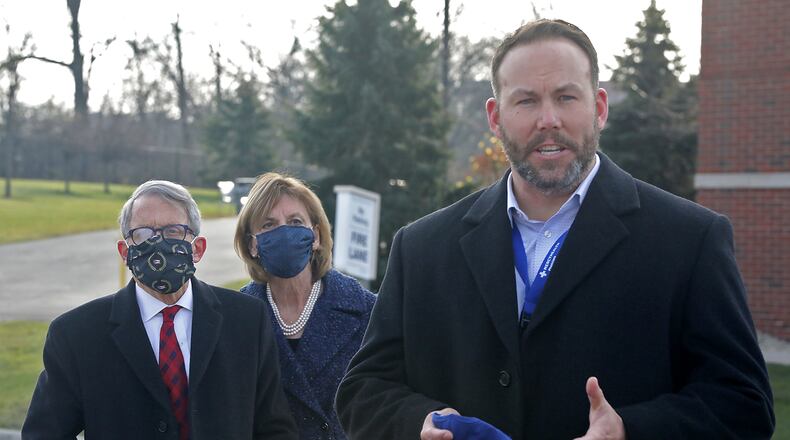Gov. Mike DeWine announced on Dec. 23 that members of Phase 1b of the state’s vaccinate distribution plan, which includes Ohioans over the age 65 and older, people who work in schools and those with severe inherited or developmental disorders, would be able to start getting vaccinated “soon.”
However, Groshans said coming up with a clear timeline for when those vaccinations will start is like “looking into a crystal ball.”
“I know that there is a high degree of urgency. I have been on those calls with the governor and he is wanting to push that,” Groshans said. “So time will tell. But I know that there is a very high degree of urgency. I would be at a loss if I gave you a definite timeframe. It’s only going to change.”
Clark County Combined Health District Commissioner Charles Patterson said there is no way to gauge when those in Phase 1b will be eligible in the county because doses continue to be “extremely limited.”
“We are extremely limited by the vaccine. The shipment that we are getting this week is 200 doses. Quick calculations, I told the state this morning that we are on target to finish by January of 2023 if they only give me 200 doses a week,” Patterson said.
According to the Ohio Department of Health’s vaccination dashboard, 2,116 vaccines had been administered in Clark County as of Monday. That’s about 1.58% of the county’s population, according to ODH.
All of those vaccinated in the county fall into Phase 1a of the state’s distribution plan. Members eligible for the vaccine in Phase 1a include: EMS responders/urban search and rescue, long-term care facility staff and residents, Local Health Department (LHD) point of dispensing personnel, correctional facility and medical staff, coroner/morgue staff conducting autopsies, home health staff and clients, group home staff and residents, residential care facilities, Federally Qualified Health Care Center, healthcare practitioners, urgent care centers, school nurses, dialysis centers, dental providers, hospice staff, pharmacists and ancillary healthcare staff.
Patterson said moving into Phase 1b of vaccinations will continue to depend on “how many doses we get.”
“If we were to get another 500 or 1,000 doses, I think we could wrap up group 1a, and then doses after that could be allocated to second doses and then initial first doses of 1b,” Patterson said. “It all depends on distribution. I mean if we get 200 doses a week for the next couple of weeks, I won’t have any to give to group 1b because I’ll have to start doing second doses for those in 1a.”
Patterson said those in 1b will likely not see vaccines until “the end of January at this point.”
“We just won’t be able to move forward unless there is some huge amount of vaccine that just falls from the sky,” Patterson said.
Aside from vaccine concerns, and with New Year’s Eve now over, Groshans said Springfield Regional is anticipating a possible post-holiday spike in COVID-19 patients.
“Some experts believe that this week that we are coming into will be the new peak of COVID, kind of that lastly holiday effect from people that do gather and just the spread and contamination from the holiday,” Groshans said. “There are other experts that feel like we have been at our high and we are running at our high due to what is known as the stacking effect.”
The stacking effect, Groshans said, is described as “like saying the bus is totally full, but as we let 10 folks off the bus, we have 10 that are waiting to get on.”
“So it’s a little bit of, as we take new admissions due to COVID, we have patients that we have been treating for several weeks that are ready to go home,” Groshans said. “So only time will tell who is most accurate. But out folks are ready and prepared.”
Clark County had 9,303 cases, 235 deaths and 12 probable deaths of the coronavirus as of Monday afternoon, according to the Ohio Department of Health.
Springfield Regional Medical Center had 44 patients hospitalized with COVID-19, according to data from the CCCHD.
Just under 6,000 cases statewide were recorded, the fourth lowest number in the last 21 days. The 5,942 cases reported Monday were nearly 1,000 less than the 6,808 cases recorded on Sunday.
The state reported 67 deaths on Monday, also under the 21-day average of 76.
In total, Ohio had 727,423 cases and 9,143 deaths on Monday, according to ODH.
About the Author

